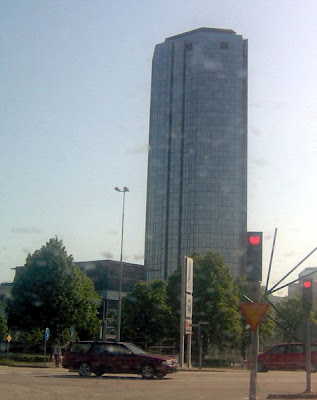 Gislaved
GislavedGislaved is a municipality in Jönköpings län in the western part in the province of Småland. The municipality have 8 towns, the largest and dominant is Gislaved itself, but exept Gislaved there is the other seven towns, these are Anderstorp, Smålandsstenar, Reftele, Hestra, Burseryd, Broaryd and Skeppshult.

100 years ago the dominant village in the area was Anderstorp, Gislaved didnt exist and was only a forested area with farms and houses. There existed small villages, Henja and Gyllenfors (wich today is only districts in Gislaved town). But one day in the beginning of the 1900-century a factory creating gummi was created between the villages of Gyllenfors and the early Gislaved. The town expanded and Gyllenfors soon dissapeared inside Gislaved. The town expanded alot in 100 years and resluted that in the municipality-reform in the 1970:ies the municipality of Anderstorp, Reftele, Smålandsstenar and Hestra all dissapeared under the municipality of Gislaved, cause now, Gislaved was the dominant town wich its rich industry.
What to see in this area in Gislaved and around is not much, but just north outside Hestra there actually is a very popular tourist spot, specially among danes and germans, this place is called Isaberg, a small mountain with about 300 meters height wick is a ski-resort in winter, and camping site in the summer. In Båraryd, a small village (not a town) in the west have a lake were bathing is popular in summer among the locals.
 Gnosjö
Gnosjö 
















 There is also a place around Älvdalen were the people speak their own unique language that only exist here, "älvdalska" or the elfdalian language. Even if the english name for the language is "elfdalian" it dont have anything to do with elfs. Even if elf means "alv" or "älva" in swedish, "älv" also reffers for rivers that flow in mountaineous regions wich is common up here, Älvdalen means "River Valley".
There is also a place around Älvdalen were the people speak their own unique language that only exist here, "älvdalska" or the elfdalian language. Even if the english name for the language is "elfdalian" it dont have anything to do with elfs. Even if elf means "alv" or "älva" in swedish, "älv" also reffers for rivers that flow in mountaineous regions wich is common up here, Älvdalen means "River Valley".
 Vänsterpartiet, in english "Left Party" is a socialistic and feministic party. Before it was called Vänsterpartiet Kommunisterna, but after the fall of Soviet Union, "kommunisterna" was deleted from the name, and now they dont see them selves as communists but socialists. The red flower they have as symbol is a red sweet-william flower (nejlika in swedish). Vänsterpartiet was created in the year 1917, same year as the Russian Revolution. It is the most "red" party in the Riksdag.
Vänsterpartiet, in english "Left Party" is a socialistic and feministic party. Before it was called Vänsterpartiet Kommunisterna, but after the fall of Soviet Union, "kommunisterna" was deleted from the name, and now they dont see them selves as communists but socialists. The red flower they have as symbol is a red sweet-william flower (nejlika in swedish). Vänsterpartiet was created in the year 1917, same year as the Russian Revolution. It is the most "red" party in the Riksdag.






 Norway have a very small population with only 4.6 million people, wich only is half of what Sweden was. The capital is Oslo, located in the south of the country. Norway is a very mountaineous country and has a very stunning natural landskape.
Norway have a very small population with only 4.6 million people, wich only is half of what Sweden was. The capital is Oslo, located in the south of the country. Norway is a very mountaineous country and has a very stunning natural landskape.




















